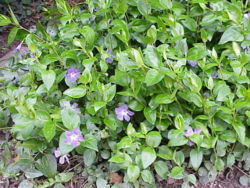Groundcover: Difference between revisions
Jump to navigation
Jump to search
No edit summary |
(No difference)
|
Latest revision as of 07:52, 3 April 2007

Groundcover is a plant used for the purpose of growing over an area of ground to hide it or to protect it from erosion or drought. In an ecosystem, the ground cover is the layer of vegetation below the shrub layer.
Strictly speaking, the most widespread groundcover are grasses of various types. In gardening terms, however, the term groundcover refers to non-grass plants that are used in place of grasses.
Four general types of plants are commonly used as groundcovers:
- Vines, which are woody plants with slender, spreading stems
- Herbaceous plants, or non-woody plants
- Shrubs of low-growing, spreading species
- Moss of larger, coarser species
Of these types, some of the most common groundcovers include:
- Bacopa (Bacopa)
- Ivy (Hedera)
- Gazania (Gazania rigens)
- Ground-elder (Aegopodium podagraria)
- Ice plant
- Japanese honeysuckle (Lonicera japonica)
- Junipers of various low-growing types
- Kudzu
- Lantana, creeping species
- Lilyturf (Liriope spicata)
- Mint (Mentha)
- Nasturtium (Tropaeolum majus)
- Pachysandra
- Pearlwort (Sagina subulata)
- Periwinkle (Vinca)
- Shasta daisy (Leucanthemum)
- Soleirolia (Soleirolia soleirolii)
- Spider plant (Chlorophytum comosum)